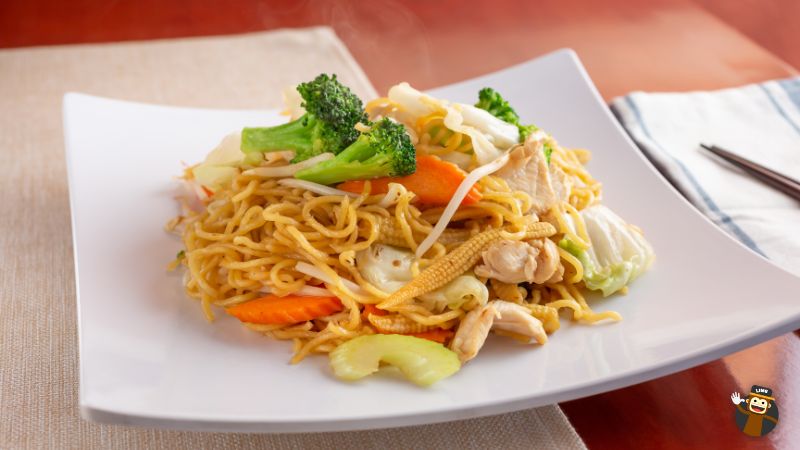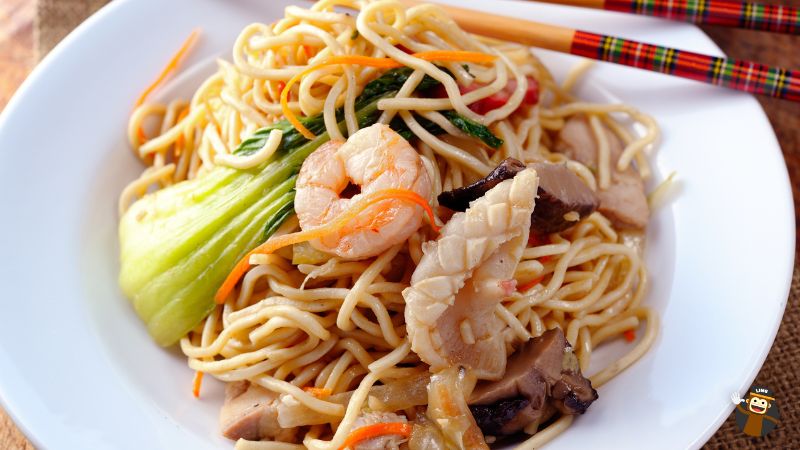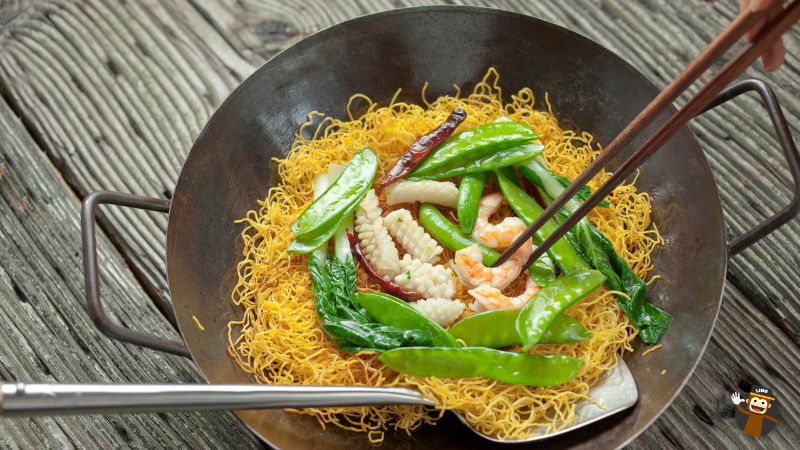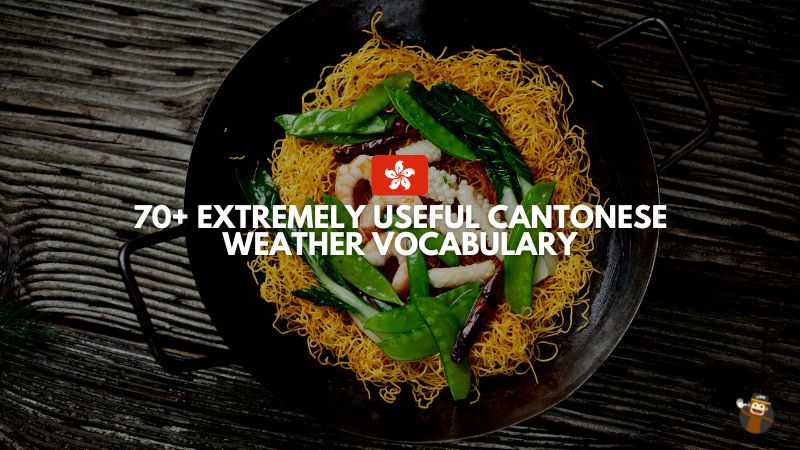When it comes to crispy pan-fried noodles, nothing beats the Cantonese chow mein. So, prepare to satisfy your cravings as we talk about this mouthwatering dish.
When you’re craving Chinese food, crispy noodles would always be our option. Cantonese Soy Sauce Chow Mein (豉油皇炒麵 si6 jau4 wong4 caau2 min6), also known as Hong Kong-style noodles, is indeed one of the most popular and well-loved Cantonese food in the world.
Chow mein ( 炒面) is a Chinese noodle dish filled with veggies and protein all tossed in a flavorful sauce. Chow mein recipes, which translate to stir-fried noodles, are often divided into two groups based mostly on the texture of the noodles.
The first one is Steamed Chow Mein which has soft noodles that have been mixed with the sauce, vegetables, and beef during the cooking process. The second one is Chow Mein Cantonese, also known as Hong Kong style chow mein and crispy chow mein. This recipe calls for a crispy bottom layer. There are different Hong Kong noodles that you can try, like Beef Chow Mein and Vegetable Chow Mein.
There are many things to discover about this all-time favorite Cantonese dish. What’s the history of Chow mein? Why do people love Chow mein noodles? What’s the difference between Chow Mein and Lo Mein? How to make Cantonese chow mein? These are just a few questions we will answer, so let’s dive right into it.
Brief History Of Chow Mein Noodles
Chow mein is a classic Cantonese dish that originated in Mainland China. It is traditionally a breakfast dish or a lunch kind of dish. It is also a popular dish for dim sum. Variations of Chow mein have arisen in different Chinese locales; there are several ways to fry the noodles and various toppings.
In the 1850s, Chinese immigrants brought chow mein to the United States. It was on the menus of many Chinese restaurants not long after chop suey became a huge hit with Americans.
Soon after, chow mein was heavily Americanized, like many other foreign foods, to appeal to Western tastes. Over time, it became more of a meat dish with deep-fried egg noodles covered in a thick sauce. It doesn’t look much like authentic Chinese chow mein anymore. However, people are turning back to more traditional recipes because the food trends are slowly changing.
Why Do People Love Cantonese Chow Mein?
Cantonese Chow Mein is indeed one of the most popular Chinese food worldwide. If you haven’t tasted it yet, here are the reasons why this Cantonese dish is trendy:
- Affordable
- It can be easily prepared
- There are wide varieties as there are different regional varieties
- It comes with nostalgia when you’re eating it
Facts About Chow Mein
Chow mein is a traditional Cantonese dish. The term chow mein refers to fried noodles. You might encounter two main chow mein dishes when you go to Hong Kong or China.
The first one is steamed chow mein. The noodles in this version of chow mein are first quickly cooked. After that, the steamed noodles are stir-fried and mixed with other ingredients like meat or veggies and coated in a light sauce. The second one is the crispy chow mein. This variety of chow mein is made by pressing the noodles flat while frying. It is topped with toppings and sauces.

The noodles have a big role in making a great Cantonese-style chow mein. Vegetables and protein are kept to a minimum to preserve the noodles’ crispness. These accompaniments are added after the noodles have been boiled and fried in oil, enabling the chef to focus on preparing the noodles to perfection.
When it comes to sauce, a chow mein recipe uses only a little sauce. It doesn’t cover its noodles in sauce, so they stay crispy. Crisp chow mein is served with a darker, more decadent sauce, softening the noodles’ crispy edge.
Chow Mein’s characteristics are:
- distinctly crispy noodles (crispy chow mein)
- oily noodles (steamed chow mein)
- protein and veggies are limited.
- the sauce doesn’t overpower or weigh down the noodles
Now, let us learn more about Cantonese style chow mein with these simple facts.
The Name Means Fried Noodles Or Dough
The dish’s name shows that it comes from the mainland of China. It has nothing to do with the American slang word for food, “chow.”
Noodles Are The Key For A Great Chow Mein
Hong Kong Style Pan Fried Noodles or Cantonese noodles are made of wheat flour, water, and egg. Crispiness or crunchiness is the signature of chow mein noodles. However, this may vary depending on the country. For example, noodles aren’t as hard in America as authentic chow mein noodles.
Chow Mein Is A Centuries-old Dish
Some historians believe that the origins of chow mein reach back to the Han Dynasty in China. According to the Metropolitan Museum of Art, the birth of chow mein may have occurred at the same time that Rome and Egypt did.
Chow Mein Is Still A Hype In School
Chow mein has always been in most school cafeterias around the world. Aside from being always available as a dish in school, chow mein is also taught to students to make a healthy dish without using healthy protein options like chicken.
Chow Mein Sandwiches Exist
It doesn’t look exactly like a sandwich, and you shouldn’t even pretend it’s something you could have on the run. It’s the typical chow mein, loaded with noodles, vegetables, and beef and smothered in sauce. However, it comes with a very tiny bun placed on top of the dish, making it nearly hard to eat with your hands.
Chow Mein Is Also Popular In India
The popularity of Chow Mein in India roots in the long history of cultural trade between China and India. It’s called chow mein, chow-chow, or just chow as street food. The Chow Mein in India has a spicier sauce and more sauce. It didn’t take a look for Chow Mein to be mainstream in India. After being popularized by packaged noodles and street food vendors in India, chow mein became a staple of Bengali households in the 1970s and 1980s.
Chow Mein Was Taken Off The Menus Of Several Restaurants
When Chow Mein was brought to America, it became an easy meal anyone could make, even if they didn’t know how to cook. As the easy version became more common, the dish lost its status, and in the second half of the 20th century, it was rarely served in fancy restaurants.
Chow Mein Continue To Evolve
As Chow Mein continues to reach different parts of the world, it also continues to evolve. The taste of chow mein depends on who is cooking. The different food trends can also influence the varieties of chow mein in every country. But, if you want the authentic chow mein taste, it is still best to go to an authentic Cantonese restaurant.

Chow Mein VS Lo Mein
The preparation style and noodles distinguish chow mein from lo mein and chow fun. It’s crucial to know the differences between Chinese noodle dishes. Here are the key differences between chow mein and low mein:
Cooking Method
Chow mein and lo mein cook differently. Before being stir-fried, chow mein noodles are softened by soaking them in hot water. The noodles and other ingredients are fully cooked throughout the stir-frying procedure. Lo mein noodles, on the other hand, are fully cooked before being combined with the meat, vegetables, and sauce they are served with. Rather than being stir-fried, the ingredients of the lo mein are simply tossed together and blended.
Wok Technique
Both noodle dishes taste best when cooked in a wok, although they are different. To make chow mein noodles, briefly cook the ingredients in a hot wok while stirring quickly. For lo mein, the noodles are already cooked and are not fried.
Texture
The way chow mein noodles are cooked makes them crunchier. Fully cooked lo mein noodles are smoother and chewier than uncooked noodles.
Sauce
Chow mein has a mild, delicate sauce if any. Lo mein relies on a thick sauce for flavor.
Ingredients Of Cantonese Style Chow Mein
Cantonese chow mein noodles can be found almost everywhere. You can sometimes find it in places you least expect. One of the reasons behind it is that it is easy to make, and the ingredients are affordable. These ingredients can be found in most Asian grocery stores, so it wouldn’t be hard for you to cook your own at home. Here are the primary ingredients of Cantonese chow mein.
- Chow Mein Noodles/Egg Noodles
- Soy Sauce
- Onion
- Green Onions
- Bean Sprouts
- Dark Soy Sauce
- Light Soy Sauce
- Oyster Sauce
- Sugar
- Water
- Sesame Oil
- Corn Oil
Steps In Cooking Cantonese Chow Mein
Cooking chow mein does not require much effort and ingredients; that is why many countries have developed versions of chow mein. Here are the steps in making a simple chow mein dish:
Step 1: Steaming, Cooking, And Draining Chow Mein Noodles
- Heat a wok with a steamer rack inside. Begin boiling water by putting in enough water to cover the top of the rack.
- If using steamed fresh noodles, skip the steaming step. Boil the noodles and then drain them after 2 minutes. If you use dried noodles, you can cook them similarly when making instant ramen. Cook as directed on the package, erring on the side of al dente, and then stop the cooking by rinsing with cold water.
- Remove the rack, divide the noodles, and arrange them in a single layer on top of the rack.
- When the water is boiling, return the steamer rack and noodles to the wok and cover for 10 minutes. Heat a wok over high heat.
- If using a steamer rack without holes, steam for 2-3 minutes longer.
- After 10 minutes, quickly dunk the noodles for 15-30 seconds. Drain noodles and fluff with a chopstick for 1-2 minutes. Let it cool for 3-5 minutes.
Step 2: Chopping Of Vegetables
- Wash the vegetables properly.
- Chop the vegetables.
- Get five pieces of green onion and cut them into 1 1/2 inches. You’ll cook the roots first, so separate them from the shoots.
- Next, get the onion, cut it in half, and cut it into long thin strips, similar to matchsticks. This cut is called julienne cut.
- The last ingredient in the recipe that you’ll need is fresh bean sprouts. Get the fresh bean sprouts. You don’t have to do anything with it, but others want the beans and tips removed. You can also use mung bean sprouts, but remember that mung beans are linked to larger beans.
- Put the vegetables on a plate and set them aside.
Step 3: Creating Chow Mein Sauce Mix
- After the vegetables, prepare all the sauce ingredients. This step is quite easy. Just get a bowl and mix 1 tbsp of oyster sauce, water, 1 tbsp of dark soy sauce, 1 tbsp of light soy sauce, and 2 tsp of sugar.
- Stir the sauce ingredients until the sugar dissolves.
Step 4: Cooking
- Get a large wok and heat it to medium-high heat for 2-3 minutes. This is around 350-400°F or 176-204°C.
- Add 0.99 tbsp corn oil and heat it in 350-400°F oil. Visually, it should be “shimmering” (rippling, not smoking). If it is smoking, this means that the wok is excessively hot.
- Start cooking the onions and green onions for around 1 minute. After that, put it on a plate and then set it aside.
- Get the wok again and add extra corn oil. When the oil begins to shimmer, add the noodles to the pan.
- The noodles should be handled with care. The noodles should not yet be flipped and should only be moved around a few times. For about three minutes, let the bottom crisp up nicely.
- After three minutes, you may now flip the noodles. Natives do a wok-flip, but a spatula can do the magic for beginners.
Step 5: Cooking Been Sprouts, Adding Veggies, Adding Flavors
- After cooking the noodles, add the bean sprouts. Push the noodles to the side of the wok to make room for the bean sprouts. To make the bean sprouts evenly cooked, trap the heat by covering them with the noodles. Let them be boiled for 30-45 seconds.
- Next, add the green onions and onions. Cook them for 1-2 minutes.
- Pour the Chow Mein sauce and mix with all the ingredients for 1 minute. Wait until the sauce evaporates.
- Add 1 tsp of sesame oil, mix and separate the noodles for another 1-2 minutes. After this, you can start plating. You can also taste the noodles to see if the flavors and color satisfy you.
Step 6: Plating And Serving
- You can now start plating when you’re already satisfied with the taste and color. Of curse, if you’re eating alone, you don’t need much work for plating. But if you want to flex it on Instagram or invite other people to eat, it wouldn’t hurt to make an effort.
Equipment In Cooking Cantonese Chow Mein

Aside from the ingredients, kitchen utensils are also crucial in cooking stir-fry noodles. Here are the essential kitchen utensils you’ll need to cook Cantonese Chow Mein and other Chinese food.
Wok
In cooking Chinese food, the wok is the most commonly used cookware. Woks are one of the most versatile cooking pans in the world, and they originated in China. Although they exist in many different materials and shapes, these circular frying pans’ trademark appearance is utilitarian and identifiable.
Big Chopsticks Or Wok Ladle (Chinese Ladle)
Wok ladles, also called Chinese ladles, seem more like giant spoons than bowl-shaped ladles. Wok ladles are built for the wok’s particular curve.
If you like stir-fry, chop suey, or chow mein, you know how flexible a wok can be. Why not add a wok ladle to your kitchen?
Steamer Rack
Steam racks are also one of the staples for cooking Chinese food. It is used in cooking our favorite dim sum. It is also important cookware in cooking chow mein noodles, but a simple plate will do the trick if you don’t have a steamer rack.
Colander
The colander or strainer will be used to drain the noodles after dumping them in hot water.
Cantonese Chow Mein Vocabulary
Level Up Your Dining Experience. Learn Cantonese Now!
Exploring Cantonese cuisine is more fun when you know how to speak Cantonese. Gladly, Ling App can give you the Cantonese language learning experience you dreamed of. With lots of topics to choose from and advanced features, you can learn Cantonese happily and meaningfully.

Nothing beats good food and good friendly conversations. Enjoy your every meal while having conversations with the locals. Start learning Cantonese with Ling App now!































































